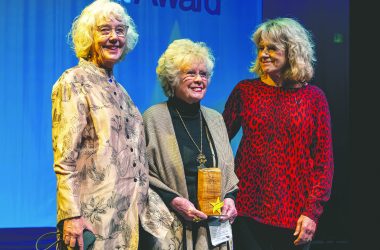 Stan Laurel and Oliver Hardy were among the original breakthrough comedy stars who still enjoy devoted fans today.
Stan Laurel and Oliver Hardy were among the original breakthrough comedy stars who still enjoy devoted fans today.
Before the motion picture, and later, television, there was vaudeville. Out of vaudeville and the music theatre and bars of Europe, came comedy teams and single comedians. In 1903, the first successful motion picture was filmed, a western – The Great Train Robbery. In the early days, most silent movies were produced in New York and sprang up in Hollywood about 1909-10. Of course, Hollywood today is the dominating motion picture headquarters of the world.
The early films consisted mainly of westerns and the Charlie Chaplin-type slapstick situation comedy. The Keystone Kops were popular as well. The silents ran into 1928 when Warner Brothers brought out the first successful sound film – The Jazz Singer. In the period between 1920-30, there were many comedians who had a 15-minute time in the spotlight. But with the coming of sound, faded into history.
Some of these were Ben Turpin, Andy Clyde, Fatty Arbuckle, and many others. Harold Lloyd, the silent screen actor famous for spectacles, but no glass – they were merely a prop, and Harry Langdon, with some success, survived into the mid-1930s in converting from silent to sound.
 Classic 16mm film projector.
Classic 16mm film projector.
The most successful comedy team to come out of the silent era and find outstanding success in the sound era was Laurel and Hardy. Both Stan Laurel and Oliver Hardy were under contract to Hal Roach, the head of Roach Studios in Culver City, Calif. His studio was close to MGM. Roach had a contract with MGM to book and distribute his films to theaters.
Laurel and Hardy made several pictures in the 1920s for Hal Roach, but never as a team. In early 1927, they appeared in a short 20-minute film, Flying Elephants. There were many in the cast, but Laurel and Hardy worked in sync and in the following picture, Roach paired them as Laurel and Hardy. That picture was Putting Pants on Phillip. Another 20-minute film. The story had Laurel as a relative coming from Scotland in Kilts. Hardy was to meet him at the boat and be his sponsor in the United States.
The film was so successful that Roach put them both under contract as the team of Laurel and Hardy. However, their contracts were never due at the same time in their entire career with Roach, which ended in 1941.
I bring this storyline to you because just the other day in a conversation with two friends I made the statement – “Well, that sounds like Laurel and Hardy.” The lady got a big smile and she talked about watching old Laurel and Hardy films on TV in the 1950s when she was growing up. It brought back memories of my childhood and the happy home that I had with my parents and later with my wife, son, and daughter.
My mother and father were Laurel and Hardy fans, too. Laurel and Hardy were popular before I was born, and I was not aware of Laurel and Hardy until the mid 1940s, when I was introduced to them in the movie theaters. Many of their old films were brought back as reruns, and were popular in the drive-in movies in the 1940s.
As a schoolboy I was interested in cinematography and movies. Long before TV, we had an 8mm projector. Several stores in Everett rented 8mm movies, a great deal like we rent a DVD today.
We would rent Laurel and Hardy, and many other films that we could run for evening entertainment. My folks would always rent films for birthday parties and holidays.
One day we were in a drug store and there was a used 16mm sound on a film projector for sale. My dad negotiated a price, and I was the only kid on the block with a sound movie projector! This stepped us up the ladder! Now we could rent 16mm sound films. Again, this is long before television.
A highlight of the late 1940s for me was to rent some of the Laurel and Hardy short sound films, such as “Hogwild,” “You’re Darn Tootin’,” and “Dirty Work.” Every other week, on Friday afternoons, my 5th- and later 6th-grade class had assembly. My teacher at the time, Ellen Johnson, was a huge fan of Laurel and Hardy. So twice a month we would run one of these 20-minute films with sound.
I remember a teacher in the room next door commenting, in a positive manner, that it was difficult for him to have his class with all the laughter in the projection room.
To wind this up, Laurel and Hardy made 34 silent shorts of 20 minutes each, 45 sound shorts of 20 minutes each, and 27 full-length motion pictures. Their last films for Roach in 1941 was “Chumps at Oxford” and “Saps at Sea.” These were popular films.
They left the studio and signed with 20th Century Fox. As a team they made several pictures at Fox, but were not up to their standards, as Stan had lost control of his creative comic genius. They signed with MGM for another few pictures that were slightly better.
Due to ill health, and out of the limelight, their popularity faded rapidly. In 1949-50, they attempted a comeback with a picture made in Italy that was unpopular and saw limited release in the United States.
They formed a comedy routine and toured Europe in 1952-53. Most of the reviews of their live-action stage routines were positive. On two different occasions, when they visited Ireland, as they pulled in Cobh County Cork, Ireland, the bells throughout the city rang their theme song, which, of course, is known as Song of the CooCoo (some call it the CooCoo Song).
I mentioned above the happiness that these films brought to my families. It was not uncommon for Matthew to have a room full of kids – they would have the projector out and Laurel and Hardy running on the screen. The kids never seemed to tire of watching this famous comedy team, as I, today, will pick up a new book or article re: Laurel and Hardy – mostly all rehash stuff I learned and read 50 years ago.
They represented a happy time in life. They come from an era in the U.S. of great hardship. Their popularity was at the height of the depression and WWII. But somehow that comedy genius has survived, from their first short to today, when people still light up when they are reminded of watching Laurel and Hardy.
One of my fond memories is standing in line half a block long, waiting for the second show at the Balboa Theatre in 1947 or ’48. The line went down the street and around the corner of the Bon Marche. The first show was sold out of the double feature – “Gallant Bess,” the True Story of the Sailor who adopted a horse During WWII on the Island of Saipan.
The companion feature was 1939 Laurel and Hardy “Swiss Miss.” Wonderful memories!
For those who might be interested in additional history, there are two movies on DVD I would recommend. “When Comedy Was King” and “The Laughing Twenties.” There are numerous books written on the history of Laurel and Hardy was well as Abbott And Costello, The Marx Brothers, and others.
Hope this brings back pleasant memories.








